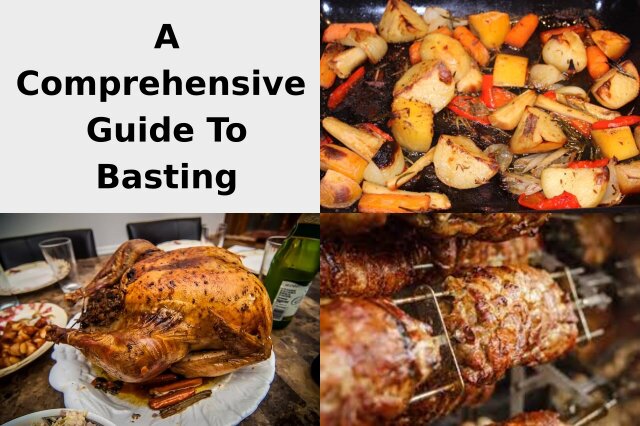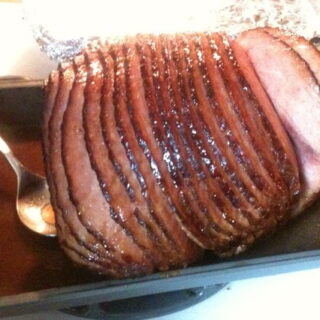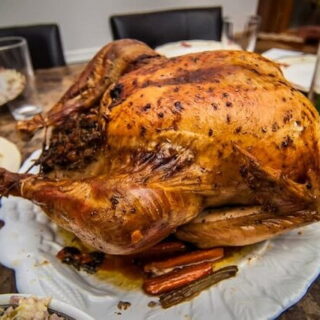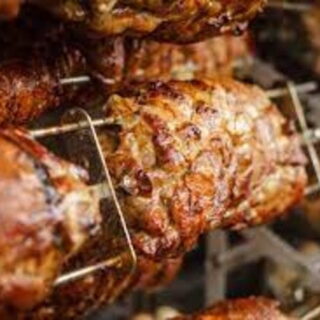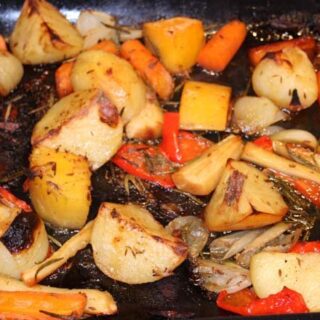Basting is a cooking technique that involves adding moisture to food while it cooks.
This can be done using pan drippings, butter, or other liquids. The purpose of basting is to keep the food moist and prevent it from drying out, while also protecting it from direct heat.
Our comprehensive guide has everything you need to know about basting, including tips and tricks for using this technique and the best tools to use.
Let’s get started and take your cooking skills to the next level!
Baste Cooking Definition –
A Comprehensive Guide to Understanding Basting in cooking
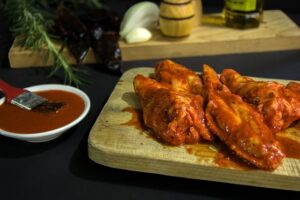 Basting is a simple yet effective way to enhance the taste and texture of your different foods in your meals.
Basting is a simple yet effective way to enhance the taste and texture of your different foods in your meals.
Get started with this easy-to-follow guide on how to baste food.
Baste Cooking Definition
What is Basting in cooking?
Basting is a method of moistening food during cooking with pan drippings, butter, or other liquids.
It helps seal in the moisture and prevents ingredients from drying out while also protecting them from direct heat.
You can use different liquids to baste depending on the type of ingredients you’re cooking and the desired flavour profile.
The process of basting can also help achieve a golden-brown texture and beautiful presentation when used correctly.
The Benefits and Uses of Basting
Basting is a great technique to use for all types of cooking. It helps your food retain more moisture, allowing it to cook more evenly and quickly.
Additionally, basting can help bring out the flavors in your dish as the juices and seasonings you use are better able to penetrate the food during cooking.
Lastly, basting can also produce a beautiful presentation with a glazed or shiny finish.
Choosing the Right Equipment for Basting
Using the proper basting tools can make a big difference in the outcome of your dish.
Basting helps to keep meat moist and flavorful, and using the right tools can ensure that the basting liquid is evenly distributed.
A basting brush with silicone bristles is ideal for applying sauces and marinades, while a baster with a needle tip is perfect for injecting flavor directly into meat.
Using the right tools can also help prevent cross-contamination and ensure food safety.
- Basting Brush;
A basting brush is a kitchen tool used to apply liquid to food during the cooking process.
It is typically made of silicone or natural bristles and can be used to apply marinades, sauces, or melted butter to meat, fish, or vegetables.When choosing a basting brush, consider the material (silicone, natural bristle, or synthetic bristle), the size and shape of the brush head, the length and type of handle, and whether it is dishwasher safe.
Look for a brush that is heat-resistant and durable, with bristles that are flexible and easy to clean.
- Basting Spoon;
A basting spoon is a long-handled spoon used to scoop up liquid from a pan and pour it over food.
It is commonly used to baste a roast during the cooking process to keep it moist and flavourful.When choosing a basting spoon, look for one with a long handle to keep your hands away from hot liquids and a large, deep bowl to hold plenty of liquid for basting.
A silicone or heat-resistant nylon spoon is ideal for use with high-heat foods, while a stainless steel or wooden spoon is great for general use.
Consider the weight and balance of the spoon, as well as any additional features like a built-in brush or angled head for easier basting.
- Basting Syringe;
A basting syringe is a tool used to inject liquid into meat or poultry.
It is commonly used to inject marinades or brines into roasts to add flavour and moisture.When choosing a basting syringe, consider the material it is made of (stainless steel or silicone are good options), the size and capacity of the syringe, and any additional features such as a cleaning brush or interchangeable needles.
It’s also important to read reviews and compare prices to find the best option for your needs and budget.
- Basting Cover;
A basting cover is a dome-shaped lid used to cover food while it is cooking.
It is commonly used to baste a steak or burger with melted cheese or to keep a roast or turkey moist while it is cooking.When choosing a basting cover, consider the size and shape of the cover to ensure it will fit over your food.
Look for a cover with a handle or knob for easy lifting and make sure it is made of heat-resistant materials.Additionally, consider the ease of cleaning and storage options.
- Basting Set;
A basting set typically includes a basting brush, spoon, and syringe.
It is a convenient way to have all the necessary tools for basting in one set.When choosing a basting set, consider the material (such as silicone or natural bristles), the size and shape of the brush, and whether it comes with a basting bulb or injector.
Look for a set that is easy to clean and comfortable to hold, and read reviews from other users to get an idea of its performance.
- Basting Pot;
A basting pot is a small pot used to heat up liquid for basting.
It is commonly used to melt butter or warm up a marinade before applying it to food.When choosing a basting pot, consider the material (stainless steel is durable and easy to clean), size (choose one that can hold enough liquid for your needs), and features (a long handle for easy basting and a tight-fitting lid to prevent spills).
Also, look for a pot with a spout for easy pouring and a non-stick interior for easy cleaning.
- Basting Tray;
A basting tray is a shallow tray used to catch drippings from meat or poultry while it is cooking.
It is commonly used to collect juices for basting or to make gravy after the meat is cooked.When choosing a basting tray, consider the material (stainless steel is durable and easy to clean), size (make sure it fits in your oven and can hold enough food), and features (handles for easy lifting, a non-stick coating for easy cleaning).
Look for a tray with high sides to prevent spills and a rack to elevate the food for even basting.
Tips and Techniques on How to Master the Art of Basting
Basting can be a tricky technique for newbies, but once you practice and get the hang of it, it will become one of your go-to cooking skills.
Here are some tips to ensure your basting goes off without a hitch:
Always baste high heat foods like poultry and beef with caution.
Make sure the liquid is applied evenly over the food – if you focus on areas more intensely than others, it can cause uneven cooking.
Lastly, check in while basting to make sure that too much liquid hasn’t been added so that the food doesn’t become oversaturated.
5 Easy Steps for How to Baste Meat, Fish and Vegetables
Basting food is an essential cooking technique used to keep meat and vegetables juicy and flavourful.
Whether you’re grilling a steak or roasting vegetables, basting with oil and seasonings adds a delicious touch of flavour to any dish.
Learn how to baste your food in five easy steps!
- Prepare the Basting Liquid;
To start, you will need to prepare the basting liquid by combining your oil and seasonings in a bowl.
If desired, you can add in herbs, lemon juice, or butter to the mixture for additional flavour.Be sure to mix all of the ingredients together thoroughly until combined.
Once complete, you are now ready to actually start basting your food! - Baste With a Spoon or Brush;
After your basting liquid has been prepared, you’ll need to decide whether you club use a spoon or a brush to actually coat your food.The main difference is that a spoon will allow for more precise coverage as opposed to the wider distribution of a brush.
If you plan to heat your basting liquid before hand, always use a spoon since brushes can get too hot. - Baste Regularly During Cooking;
Even after you have pre-tested and brushed your basting liquid onto your meat, fish, or vegetables, you’ll need to baste regularly during cooking.
This will help to keep the meat moist while adding flavour and texture.Depending on how you are cooking the food (i.e. baking, roasting, grilling) be sure to check it periodically and brush or spoon more of the basting liquid as needed.
Additionally, if you want a crispier exterior of your food after cooking, wait until the end to add more of your basting liquid.
- Temperature and Time Tips;
When basting food, it’s important to keep an eye on the temperature and time.
Keep your oven temperature above 350°F (176°C) when roasting or baking to ensure food is cooked through.When grilling, make sure that you start with a low heat setting to ensure that the surface of the food is not burnt before you can apply more basting liquid.
Additionally, allow enough cooking time to thoroughly cook the meat or vegetables.Use a meat thermometer to check for doneness.
If the temperature has already reached its final desired temperature, stop adding basting liquid as well.
- Use a Thermometer to Verify Doneness;
Before serving your food, make sure to use a thermometer to double-check that the food is done.
This helps you avoid undercooking or overcooking your meal.
Different meats have different internal temperatures, so be sure to check what temperature you need before serving.
A ChefStemp thermometer is the ideal tool for anyone looking to cook accurately and on time.
Using the ChefStemp thermometer helps you determine the optimal temperature for cooking meats, poultry, fish, eggs, and other recipes.With a large LCD display and easy-to-read temperature indicators, it also provides fast and accurate readings for quick results in both Celsius and Fahrenheit.
- ChefsTemp Pocket Pro
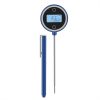
- Description:Professional thermocouple probe sensor with 1 second reading time, this pocket size kitchen gadget is suitable for both professional chefs and home cooks. Pocket Pro is another amazing innovation from ChefsTemp. It is a 4-way rotating display thermometer,
- Price: $34.99
- ChefsTemp Finaltouch X10
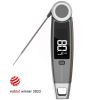
- Description:Finaltouch X10 is the Winner of Red Dot Product Design in 2022. The Red Dot Design Award is one of the three most prestigious professional design competitions in the world. Winning the award proves its the Leader in Design and Technology. Chefs around the
- Price: $69.99
- ChefsTemp Quad Xpro
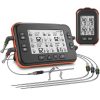
- Description:Quad XPro is designed to track temperatures over an extended period of time with moderate-heat cooking methods, such as smoking, oven-roasting, deep-frying, home brewing, and Sous Vide and to be used while grilling.
- Price: $109.99
When using a basting liquid, it’s recommended to wait until the last 10 minutes of cooking the food before applying it.
This will help ensure that the food is properly cooked and any bacteria from the basting liquid has been killed.
Learn How to Baste Food
Preparing restaurant-level food doesn’t have to be daunting.
A simple yet effective method you can add to your kitchen repertoire is basting — a technique that involves brushing a flavourful liquid onto the surface of cooked food. Read on to find out how to baste like a pro!
Master the Art of Basting Ham with This Guide
This guide will teach you everything you need to know to make a delicious ham for any occasion using classic ham basting recipe Ingredients
Ingredients
- 1 cup brown sugar
- ½ cup honey
- ½ cup Dijon mustard
- ¼ cup apple cider vinegar
- ¼ cup pineapple juice
- ¼ cup water - 1/4 cup unsalted butter
- 1 tsp ground cinnamon
- ½ tsp ground cloves
- ½ tsp ground nutmeg
Instructions
- In a saucepan, combine all the ingredients and bring to a boil over medium heat.
- Reduce the heat and let it simmer for 10-15 minutes, stirring occasionally.
- Remove from heat and let it cool.
- Brush the ham with the basting sauce.
- Place the prepared ham onto a roasting rack in your preheated oven and baste every 20 minutes during cooking.
Cook until it reaches an internal temperature of 74°C (165°F). - Baste again with additional flavoured liquid before serving to enhance the flavour of your delicious meal!
How to Baste a Chicken: A Step-by-Step Guide
Follow this guide to learn how to do it like a pro.
Ingredients
- 1 roasting chicken
- ½ cup of melted butter
- ¼ cup of olive oil
- 2 tablespoons of minced garlic
- 2 tablespoons of chopped fresh herbs such as rosemary, thyme, and parsley
- 1 tablespoon of lemon juice
- salt and pepper to taste
Instructions
- Preheat your oven:
Preheat your oven to 190°C (375°F). - Prepare your chicken:
Rinse your chicken and pat it dry with paper towels.
Season it with salt and pepper, both inside and out. - Mix your basting ingredients:
In a small bowl, mix together the melted butter, olive oil, minced garlic, chopped herbs, lemon juice, salt, and pepper. - Baste your chicken:
Using a basting brush or basting spoon, generously coat the chicken with the basting mixture.
Make sure to get the mixture into all the nooks and crannies of the chicken. - Roast your chicken:
Place the chicken in a roasting pan and roast it in the preheated oven for about 1 1/2 to 2 hours, or until the internal temperature of the chicken reaches 74°C (165°F). - Baste your chicken again:
Every 30 minutes or so, remove the chicken from the oven and baste it with the remaining basting mixture.
This will help keep the chicken moist and flavourful. - Let your chicken rest:
Once the chicken is fully cooked, remove it from the oven and let it rest for about 10 minutes before carving.
This will allow the juices to redistribute throughout the meat, making it more tender and juicy. - Serve and enjoy: Carve the chicken and serve it with your favorite sides.
Enjoy your deliciously basted chicken!
How to Baste Roast Meat for Juicy and Flavourful Results
Learn how to baste meat with this easy-to-follow guide using classic Basting Recipe Ingredients!
Ingredients
- 1 cup of beef or chicken broth
- ½ cup of melted butter
- 2 cloves of minced garlic
- 1 tablespoon of Worcestershire sauce
- Salt and pepper to taste
Instructions
- Preheat your oven:
Preheat your oven to 110°C (225°F). - Prepare your meat:
Rinse your meat and pat it dry with paper towels.
Season it with salt and pepper. - Mix your basting ingredients:
In a small bowl, mix together the melted butter, broth, minced garlic, Worcestershire sauce, salt, and pepper. - Baste your meat:
Using a basting brush or basting spoon, generously coat the roast with the basting mixture.
Make sure to get the mixture into all the nooks and crannies of the meat. - Roast your meat:
Place the meat in a roasting pan and roast it in the preheated oven.
The size and shape of your roast makes a difference in cooking time.
As a general rule of thumb, at 110°C (225°F), cook your roast for about 30 minutes per 450 grams/pound, - Baste your meat again:
Every 15 - 20 minutes or so, remove the meat from the oven and baste it with the remaining basting mixture.
This will help keep the chicken moist and flavourful. - Let your meat rest:
Once the roast is fully cooked, remove it from the oven and let it rest for about 10 minutes before carving.
This will allow the juices to redistribute throughout the meat, making it more tender and juicy. - Serve and enjoy:
Carve and serve it with your favourite sides.
Enjoy your deliciously basted roast!
How to Baste Vegetables for a Delicious and Healthy Meal
Follow these steps to learn how to baste vegetables for a tasty and healthy meal.
Ingredients
- 2 tablespoons of olive oil
- 1 tablespoon of balsamic vinegar
- 1 teaspoon of honey
- pinch of salt and pepper
Instructions
- Choose your vegetables:
Select your favorite vegetables such as carrots, broccoli, cauliflower, zucchini, or bell peppers.
Cut them into bite-sized pieces for easy cooking. - Heat up the skillet:
Place a skillet on medium heat and add a tablespoon of olive oil or butter. Let it heat up for a minute or two. - Add the vegetables:
Once the skillet is hot, add the vegetables and stir them around to coat them in the oil or butter.
Let them cook for a few minutes until they start to soften. - Make the basting sauce:
In a small bowl, mix together the olive oil, balsamic vinegar, honey and salt and pepper. - Baste the vegetables:
Using a pastry brush or spoon, baste the vegetables with the sauce.
Make sure to coat them evenly. - Cook the vegetables:
Let the vegetables cook for a few minutes, stirring occasionally, until they are tender and caramelised. - Serve and enjoy:
Once the vegetables are cooked to your liking, remove them from the skillet and serve them hot.
They make a great side dish for any meal or can be enjoyed on their own as a healthy snack.
